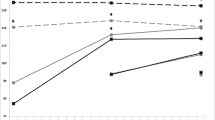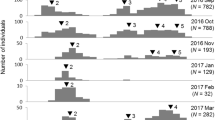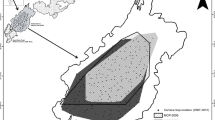Abstract
Body weight of common shrews was monitored for five years in free-living animals under mark-recapture technique. In young shrews of their first summer of life, the weight in June was significantly less at the first registration. Body weight of young shrews increased from June to August and dropped to the minimum in November. After wintering, body mass in males jumped following sexual maturation. No other variation in body weight related to sexual activity was found in males. Young females which reproduced in their first summer revealed significant increasing of body mass during reproductive activity. The maximum weight of a pregnant young female was 17.7 g, close to the maximum weight of the pregnant overwintered animal—18.7. The end of gestation in both young and overwintered females is marked by sharp and sustainable diminishing of weight. The weight of lactating young females is greater than that of immature females. When young females were not reproductively active, no signs of former reproductive activity were observed. However, in the years with notable participation of young females in reproduction, body weight of individuals without visible signs of sexual activity was significantly greater. Body weight of pregnant overwintered females was greater than that of females with lactation, and the weight of the latter was greater than that of females without signs of reproductive activity. Body weight of adult females in the trapping sessions when reproduction activity was more intensive was greater. We hypothesized that the effect of the first capture resulted from diminishing of body mass when young began feed on their own; hence, the effect could indicate shrews that just weaned. We propose using body weight as an indicator of reproductive activity in a population of the common shrews studied with mark-recapture technique.






Similar content being viewed by others
References
Bajkowska U, Chętnicki W, Fedyk S (2009) Breeding of the common shrew. Sorex araneus. under laboratory conditions. Folia Zool 58:1–9
Bauer K (1960) Die Säugetiere des Neusiedlersee-Gebietes (Österreich). Bonner zoologische Beiträge. 11:141–344
Bobretzov AV (2004) The common shrew. In: Kuprianov AG (ed) Mammals of the Pechora-Ilych Nature Reserve. Komi Book Publishing House, Syktyvkar, pp 46–64 (In Russian)
Bolshakov VN. Vasiliev AG. Sharova LP (1996). Fauna and Population Ecology of Shrews in the Urals (Mammalia. Soricidae). Ekaterinburg Publishing House. Ekaterinburg (In Russian)
Brambell FWR (1935) Reproduction in the common shrew (Sorex araneus Linnaeus). I. The oestrous cycle of the female. II. Seasonal changes in the reproductive organs of the male. Philos Trans Roy Soc B. 225:1–62. https://doi.org/10.1098/rstb.1935.0006
Churchfield S (1981) Water and fat contents of British shrews and their role in seasonal changes in body weight. J. Zool 194:165–173. https://doi.org/10.1111/j.1469-7998.1981.tb05767.x
Churchfield S (1990) The Natural History of Shrews. Christopher Helm, London
Churchfield S, Hollier J, Brown VK (1995) Population dynamics and survivorship patterns in the common shrew Sorex araneus in southern England. Acta Theriol 40:53–68
Churchfield S, Rychlik L, Taylor JRE (2012) Food resources and foraging habits of the common shrew. Sorex araneus: does winter food shortage explain Dehnel’s phenomenon? Oikos 121:1593–1602. https://doi.org/10.1111/j.1600-0706.2011.20462.x
Churchfield S. Searle JB (2008) Common shrew. In: Harris S. Yalden DW (eds) Mammals of the British Isles. Handbook 4th edn. The Mammal Society. London. pp. 257–265.
Croin Michielsen N (1966) Intraspecific and interspecific competition in the shrews Sorex araneus L. and S. minutus L. Archives Néerlandaises de Zoologie 17:73–174
Crowcroft P (1957) The Life of the Shrew. Max Reinhardt, London
Crowcroft P (1964) Note on the sexual maturation of shrews (Sorex araneus Linnaeus. 1758) in captivity. Acta Theriol 8:89–93
Dehnel A (1949) Studies on the genus Sorex L. Annales Universitatis Mariae Curie-Skłodowska C. 4:17–102. (In Polish. with English summary).
Dokuchaev NE (1990) Ecology of shrews in north-east Asia. Nauka, Moscow (In Russian)
Dokuchaev N (1992) Methods of uterus research in shrew females (Mammalia. Insectivora. Soricidae). Zoologičeskij žurnal 71(8):132–135
Dokuchaev NE (2005) Reproduction of shrews (Sorex) in Siberia. In: Merritt JF. Churchfield S. Hutterer R. Sheftel BI (eds). Advances in the biology of shrews II. Special Publication of the International Society of Shrew Biologists. New York. pp. 425-438.
Hausser J. Hutterer R. Vogel P (1990). Sorex araneus Linnaeus. 1758 – Waldspitzmaus. In: Niethammer J. Krapp F. (eds) Handbuch der Säugetiere Europas. Band 3/1. Aula-Verlag. Wiesbaden. pp. 237–278.
Hyvärinen H, Heikura K (1971) Effects of age and seasonal rhythm of the growth patterns of some small mammals in Finland and Kirkines. Norway. J. Zool. 165:545–556
Ivanter EV, Ivanter TV (1983) Ecological structure and dynamics of the population of small mammals in the Ladoga area. Fauna and ecology of birds and mammals of the North-West of the USSR. Petrozavodsk, In, pp 72–99 (In Russian)
Ivanter EV. Ivanter TV. Makarov AM (1994). The territorial and demographic structures of a common shrew population. In: Merritt JF. Kirkland GL Jr. Rose RK (eds). Advances in the Biology of Shrews. Carnegie Museum of Natural History. Special Publication. Pittsburgh. No 18. pp. 89–96.
Ivanter EV. Makarov AM (2001). Territorial Ecology of Red-Toothed Shrews (Insectivora. Sorex). PetrGU. Petrozavodsk (In Russian).
Kaikusalo A. Tast J (1994). Latitudinal variation in the life histories of Sorex araneus and S. caecutiens in Finland. In: Merritt JF. Kirkland GL Jr. Rose RK (eds). Advances in the Biology of Shrews. Carnegie Museum of Natural History. Special Publication. Pittsburgh. No 18. pp. 1-13.
Kalinin AA. Demidova TB. Oleinichenko VY. Shchipanov NA (2008) Seasonal dynamics in numbers of red-toothed shrews (Insectivora. Soricidae). Zoologicheskii Zhurnal. 87:218–225. (In Russian. with English summary).
Kowalska-Dyrcz A (1967) Sexual maturation in young male of the common shrew. Acta Theriol. 12:172–173
Kuprianova IF (1994) The common shrew. In: Bolshakov VN (ed). Fauna of North-western European Russia. vol. II. part 1. Mammals – Insectivores. Bats. Lagomorphs. Rodents. Nauka. Saint Petersburg. pp. 11–25. (In Russian).
Mercer SJ. Searle JB (1994) Captive breeding of the common shrew (Sorex araneus) for chromosomal analysis. In: Merritt JF. Kirkland GL Jr. Rose RK (eds). Advances in the Biology of Shrews. Carnegie Museum of Natural History. Special Publication. Pittsburgh. No 18. pp. 271-276.
Oleinichenko VY. Demidova TB. Kalinin AA. Shchipanov NA (2011) Notes on reproductive behaviour of the common shrew (Sorex araneus. Insectivora. Soricidae) in captivity. Zoologicheskii Zhurnal. 90: 199–205. (In Russian. with English summary).
Pucek Z (1960) Sexual maturation and variability of the reproductive system in young shrews (Sorex L.) in the first calendar year of life. Acta Theriol. 3:269–296
Pucek Z (1964) Morphological changes in the shrews kept in captivity. Acta Theriol. 8:137–166
Pucek Z (1965) Seasonal and age changes in the weight of internal organs of shrews. Acta Theriol. 10:369–448
Searle JB (1985) Methods for determining the sex of common shrews (Sorex araneus). J. Zool. 206:279–282. https://doi.org/10.1111/j.1469-7998.1985.tb05655.x
Shchipanov NA (1986) Ecologie de Crocidura suaveolens. Zoologičeskij žurnal. 65(7):1051–1060
Shchipanov NA (2020) Assessment of the population density of small mammals through capture-mark-recapture in live-traps arranged in lines. Zoologicheskii zhurnal. 99(9):1062–1076
Shchipanov NA. Kalinin AA. Demidova TB et al (2005) Population ecology of red-toothed shrews. Sorex araneus. S. caecutiens. S. minutus. and S. isodon. in Central Russia. In: Merritt JF. Churchfield S. Hutterer R. Sheftel BI (eds). Advances in the biology of shrews II. Special Publication of the International Society of Shrew Biologists. New York. pp. 201-216.
Shchipanov NA, Kalinin AA, Oleinichenko VY, Demidova TB, Goncharova OB, Nagornev FV (2000) On methods of studying the space usage by red-toothed shrews. Zoologicheskii zhurnal. 79(3):362–371
Shchipanov NA, Zima J, Churchfield S (2019) Introducing the common shrew. Shrews. Chromosomes and Speciation. Cambridge University Press. Cambridge. pp. 19–67. https://doi.org/10.1017/9780511895531
Sheftel BI (1989) Long-term and seasonal dynamics of shrews in Central Siberia. Annls Zool Fennici. 26:357–369
Stein GHW (1961) Beziehungen zwischen Bestandsdichte und Vermehrung bei der Waldspitzmaus. Sorex araneus. und weiteren Rotzahn-spitzmausen. Zeitschrift für Säugetierkunde. 26:1–16
Vlasák P (1973) Vergleich der postnatalen Entwicklung der Arten Sorex araneus L. Und Crocidura suaveolens (Pall.) mit Bemerkungen zur Methodik der Laborzucht (Insectivora. Soricidae). Věstník Československé Společnosti Zoologické. 37:222–233
Vlasák P (1998) Size of litters of the common shrew (Sorex araneus) in the Czech and the Slovak Republics. Acta Universitatis Carolinae – Biologica. 42:43–50
Zima J, Searle JB (2019) Milestones in common shrew chromosomal research. Shrews. Chromosomes and Speciation. Cambridge University Press. Cambridge. pp. 1–18. https://doi.org/10.1017/9780511895531.002
Acknowledgments
This work was supported by the Russian Foundation for Basic Research (grant № 19-04-00985).
Author information
Authors and Affiliations
Corresponding author
Additional information
Communicated by: Jan M. Wójcik
Publisher’s note
Springer Nature remains neutral with regard to jurisdictional claims in published maps and institutional affiliations.
Rights and permissions
About this article
Cite this article
Shchipanov, N.A., Artamonov, A.V. & Demidova, T.B. Body weight as an indicator of the reproduction rate in population of the common shrew. Mamm Res 66, 327–337 (2021). https://doi.org/10.1007/s13364-020-00554-3
Received:
Accepted:
Published:
Issue Date:
DOI: https://doi.org/10.1007/s13364-020-00554-3




